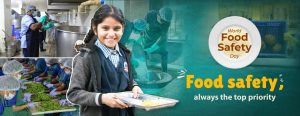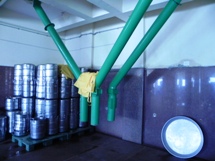
7:00 AM I slipped into a pair of over sized slippers, tucked my hair into a shower cap, and stepped into the hot and steamy kitchen, where human-sized cauldrons full of rice and sambhar were brewing. On my right, several large metal baskets were being filled with the exact same quantity of rice at the simple press of a button. Workers carried these containers and placed them under a row of faucets, where pressurized water filled the bowls and cleansed the rice. I turned back around to see water gush out from the bottom of the cauldrons. Clearly, the rice was being drained and it was ready to be packed.
| India has double the rate of malnutrition of sub-Saharan Africa. Indian children enlist in menial jobs just so they can earn enough money to have one solid meal a day. As a result, about 13.5 million children in India do not attend school. |
7:15 AM An aromatic smell was coming from the room on my right. I followed the smell into the area next door and my mouth salivated at the sight of a large bath full of sambhar with metal pipes protruding outwards from it. Vast amounts of sambhar emerged from the pipes and drained perfectly into steel pots below. I looked back up at the large bath and there were almost no traces of sambhar left. The steel pots sat on a conveyor belt and I tracked the containers as they moved into a room on the left. I watched in amazement as the belt transported dozens of tightly packed stainless steel vessels to custom-built Akshaya Patra trucks.
7:30 AM I looked at the clock on my wrist and the large hand was close to the “6.” The trucks had just revved their engines and started to drive away. They were on route to schools within 50 kilometers of the kitchen with enough food for 5,000 children packed in the back of their vehicles. Inside the kitchen, the workers acted in a mechanized fashion to swiftly move the pots and steam-clean every inch of the kitchen. Usha (an Akshaya Patra representative) then escorted me outside, and as we walked towards the dining hall she started telling me about the intelligently engineered kitchens.
India has double the rate of malnutrition of sub-Saharan Africa. Indian children enlist in menial jobs just so they can earn enough money to have one solid meal a day. As a result, about 13.5 million children in India do not attend school. Numerous studies have shown that education is the single most powerful factor that can take an entire family out of the poverty cycle, and within one generation, education can significantly improve one’s quality of life.
Akshaya Patra helps underprivileged children by serving one healthy, balanced mid-day meal at school and thus incentivizes children to continue their education. Akshaya Patra has become the largest mid-day meal program in the world and currently serves food to about 1.2 million children in India everyday.
I think it is truly incredible how just Akshaya Patra has such widespread impact on many different areas of society, such as health, education, gender inequality, and poverty, with just one solution- serving mid-day meals to school children. The government schools have measured Akshaya Patra’s impact and they have seen an increase in school enrollment, an increase in attendance, an increase in school performance, and a reduction in dropout rates. Additionally, malnutrition has decreased and socialization among all social castes has increased..
I visited on a Tuesday morning and tasted the mouth-watering khichidi, sabzi, and sambhar that would be served to the school children later that day. It was so tasty that I asked for more and more servings. I think it is absolutely amazing how Akshaya Patra has utilized technology to consistently provide such delicious and nutritious food to starving children. Now, I wonder what Akshaya Patra has in store for the future…











